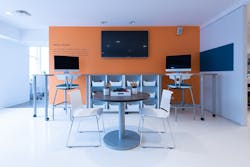KI’s Chicago Showroom Adapts to the Changing Workplace
The Sunday before NeoCon 2016, I had the opportunity to tour the KI showroom in Chicago with Shawn Green, vice president of design and product marketing, looking at the way in which they set up their space to showcase application over product. Two years later, Green and I revisited the space, what has happened over the last 24 months, and how changes in the marketplace are reflected in the showroom.
The 15,000 square foot space has been the recipient of the Best Large Showroom design award for the last several years. “To be recognized by your peers for design and application, in particular interior design using our products, is really, for us, quite flattering,” Green explained. The highlight of interior design’s use in the space has been emphasized—both in 2016 and two years later; you won’t find any pedestals in KI’s showroom. Instead, people lounge throughout, holding impromptu meetings over cups of coffee provided by the company at the hospitality bar.
“My hypothesis, and that of my design team, is that the showroom should be experiential. It should provide a platform for conveying ideas,” Green said. “When we build the space, we look at it from the context of how people will behave within an office setting, what would be the things that they would be looking for, and the product attributes.
Application Showroom
“We really wanted our showroom to be more like a test drive,” he continued. “We wanted our products to be shown in application, but within the context that is much more relevant. When we look at space, we really simplify it from a behavioral standpoint and rely upon the fact that we believe you need four behavioral types to be successful in an environment: a place to focus, places where you can interact, places where you can share and create or ideate, and then lastly, places where you can just get away from it all—so rejuvenation and relaxation.”
▼▼▼ Keep Scrolling. The article's not done!▼▼▼Green describes this change in the space that is reflected in offices across the country as “different than a manager station or clerical station; that was all task-specific, and we’re moving into behavioral-based programming and allowing that to be the primary driver for applications.”
The use of offices has changed over the last several decades from “task-specific” to creative and cognitive work, evidenced through the redesign of workspaces to include collaborative work areas. “We say things like ‘people are collaborating,’ which is kind of silly because they’ve always collaborated,” he said. “But to drive higher levels of interaction and to have more reliance upon groups as opposed to individuals is something that is more unique and that is evolving; it has changing needs.”
Feel Good: 3 Charitable Interior Design Stories
Workplace Interaction and Creativity
This change in mindset about the office being a space for group interaction and creativity has, in turn, changed the way in which office furniture is viewed. A task chair has its purpose, but they are not the only places in which tasks are performed, opening the door to a wide variety of lounge furniture to be utilized.
Another important aspect of office design that KI takes into consideration is how new employees are accustomed to working. With many coming straight from a university setting, KI is using their educational furniture to inspire how they design for corporate environments. “We’ve basically [said], ‘Look, we know college campuses really well; we know that these students are going to graduate, they’re going to go into the corporate environment, and these are the things that they’re going to take with them in terms of their expectations from a visual standpoint,’” Green explained. “We believe that having more color, more pattern, more visual variation is important to stimulate creativity as well as to connect back to this idea of campus-to-corporate.”
“It’s really important to go down as far as you can—even getting into K through 12—if you want to understand what the future’s going to be like, to a certain degree.”
About the Author

Kadie Yale
Former Editor-in-Chief
Kadie Yale holds a BA in Industrial Design from San Francisco State University and a MA in Decorative Art History and Theory from Parsons the New School. In her role as editor-in-chief from 2015-2018, she led the interiors+sources team in creating relevant content that touches on sustainability, universal design, science, and the role of design in society.
